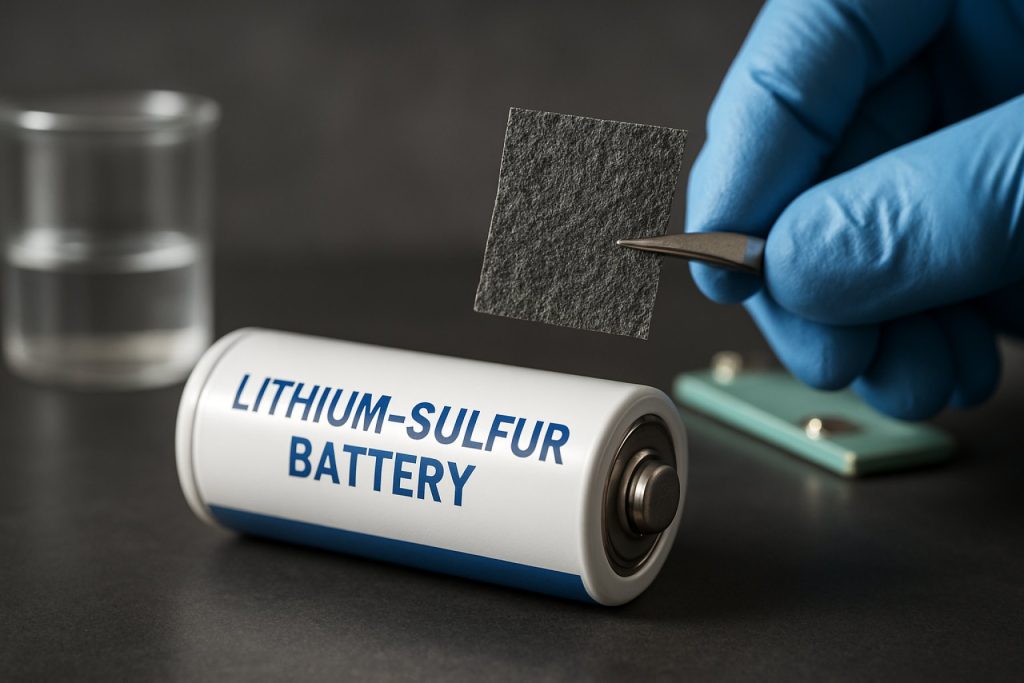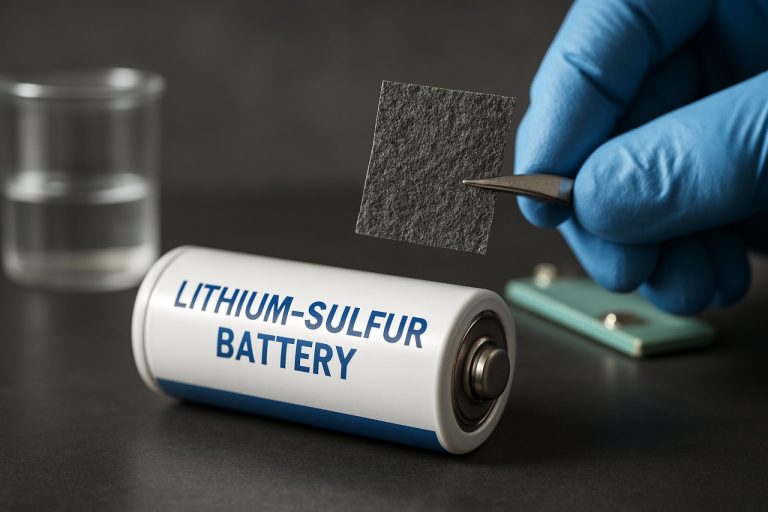
Lithium-Sulfur Battery Cathode Engineering Market Report 2025: In-Depth Analysis of Growth Drivers, Technology Innovations, and Strategic Opportunities for the Next 5 Years
- Executive Summary & Market Overview
- Key Technology Trends in Lithium-Sulfur Cathode Engineering
- Competitive Landscape and Leading Players
- Market Growth Forecasts and CAGR Analysis (2025–2030)
- Regional Market Analysis: North America, Europe, Asia-Pacific, and Rest of World
- Future Outlook: Emerging Applications and Investment Hotspots
- Challenges, Risks, and Strategic Opportunities
- Sources & References
Executive Summary & Market Overview
Lithium-sulfur (Li-S) battery cathode engineering represents a pivotal frontier in next-generation energy storage, promising significant advancements over conventional lithium-ion technologies. As of 2025, the global push for higher energy density, reduced costs, and improved sustainability in batteries is driving intense research and commercialization efforts in Li-S cathode design. The Li-S system leverages sulfur’s high theoretical capacity (1,675 mAh/g) and abundance, offering the potential for batteries with up to five times the energy density of current lithium-ion cells, while also reducing reliance on critical minerals like cobalt and nickel.
The market for Li-S battery cathode engineering is rapidly evolving, with key players including OXIS Energy, Sion Power, and Lithium-Sulfur Batteries Inc. advancing proprietary cathode materials and architectures. According to MarketsandMarkets, the global Li-S battery market is projected to grow at a CAGR of over 30% from 2023 to 2028, driven by demand from electric vehicles (EVs), aerospace, and grid storage sectors.
Despite its promise, Li-S cathode engineering faces technical hurdles, notably the polysulfide shuttle effect, which leads to rapid capacity fading and limited cycle life. In response, research is focused on advanced cathode architectures, such as encapsulation of sulfur in porous carbon matrices, use of conductive polymers, and development of solid-state electrolytes. These innovations aim to stabilize the cathode, enhance conductivity, and suppress polysulfide migration, as highlighted in recent studies by Nature Energy.
Strategic investments and partnerships are accelerating commercialization. For instance, Airbus is collaborating with battery developers to integrate Li-S technology into next-generation aircraft, targeting significant weight reductions and longer flight ranges. Meanwhile, government initiatives in the US, EU, and Asia are funding pilot projects and scaling up manufacturing capabilities, as reported by International Energy Agency (IEA).
In summary, Li-S battery cathode engineering is at a critical inflection point in 2025, with breakthroughs in material science and manufacturing poised to unlock commercial viability. The sector’s trajectory will be shaped by continued innovation, strategic alliances, and supportive policy frameworks, positioning Li-S batteries as a transformative solution for the future of energy storage.
Key Technology Trends in Lithium-Sulfur Cathode Engineering
Lithium-sulfur (Li-S) battery cathode engineering is undergoing rapid innovation, driven by the need for higher energy density, improved cycle life, and cost-effective alternatives to conventional lithium-ion batteries. As of 2025, several key technology trends are shaping the development and commercialization of Li-S cathodes.
- Advanced Sulfur Host Materials: Researchers are increasingly focusing on nanostructured carbon materials, such as graphene, carbon nanotubes, and hollow carbon spheres, to serve as sulfur hosts. These materials enhance electrical conductivity and physically confine polysulfides, mitigating the notorious “shuttle effect” that leads to capacity fading. Companies like Sion Power and OXIS Energy have reported significant progress in integrating such hosts into commercial prototypes.
- Polysulfide Management Strategies: The dissolution and migration of lithium polysulfides remain a primary challenge. In 2025, the use of functional interlayers, such as polymer or ceramic coatings, and the incorporation of catalytic additives are gaining traction. These approaches chemically anchor polysulfides or accelerate their conversion, as highlighted in recent publications by Nature and Elsevier.
- Solid-State and Hybrid Electrolytes: The transition from liquid to solid-state or gel polymer electrolytes is a major trend, aiming to suppress polysulfide shuttling and enhance safety. Companies like Solid Power are actively developing solid-state Li-S cells, which promise higher stability and energy density.
- High-Loading and Lean-Electrolyte Designs: To bridge the gap between laboratory performance and commercial viability, there is a push toward high-sulfur-loading cathodes and lean-electrolyte configurations. This trend is evident in the latest prototypes from Lithium-Sulfur Batteries Inc., which demonstrate improved gravimetric and volumetric energy densities.
- Scalable Manufacturing Techniques: Efforts are underway to adapt cathode fabrication methods—such as roll-to-roll coating and 3D printing—for mass production. These scalable processes are essential for reducing costs and enabling widespread adoption, as noted in industry analyses by IDTechEx.
Collectively, these trends are accelerating the path toward commercially viable Li-S batteries, with 2025 expected to see further breakthroughs in cathode engineering and pilot-scale deployments.
Competitive Landscape and Leading Players
The competitive landscape of lithium-sulfur (Li-S) battery cathode engineering in 2025 is characterized by a dynamic mix of established battery manufacturers, innovative startups, and academic-industry collaborations. The sector is driven by the urgent need for next-generation energy storage solutions with higher energy density, lower cost, and improved sustainability compared to conventional lithium-ion batteries.
Key players in this space include Samsung SDI, which has made significant investments in sulfur cathode material research, focusing on proprietary coatings and electrolyte additives to mitigate polysulfide shuttle effects. Sion Power is another notable company, leveraging its Licerion technology to enhance cycle life and energy density, with pilot-scale production targeting electric vehicle (EV) and aerospace applications.
Startups such as OXIS Energy (now part of Advanced Battery Concepts) have pioneered lithium-sulfur pouch cells, although commercialization has faced challenges due to cathode degradation and electrolyte optimization. Meanwhile, Li-S Energy in Australia is scaling up its proprietary nanomaterial-enhanced cathode technology, aiming for commercial deployment in drones and grid storage by 2025.
Academic-industry partnerships are also shaping the field. For example, Tesla has reportedly collaborated with research institutions to explore high-loading sulfur cathodes and advanced binders, seeking breakthroughs that could be integrated into future battery packs. Contemporary Amperex Technology Co. Limited (CATL) is investing in R&D for Li-S cathode materials, with a focus on scalability and supply chain integration.
- IDTechEx projects that the Li-S battery market will reach $6 billion by 2033, with cathode engineering being a critical differentiator among competitors.
- Patent activity in sulfur cathode compositions and manufacturing processes has intensified, with Google Patents showing a surge in filings from both established firms and new entrants.
- Strategic alliances, such as those between material suppliers and cell manufacturers, are accelerating the translation of laboratory advances into commercial products.
Overall, the competitive landscape in 2025 is marked by rapid innovation, with leading players racing to overcome technical barriers in cathode engineering to unlock the full potential of lithium-sulfur batteries.
Market Growth Forecasts and CAGR Analysis (2025–2030)
The lithium-sulfur (Li-S) battery cathode engineering market is poised for significant expansion between 2025 and 2030, driven by the urgent demand for next-generation energy storage solutions in electric vehicles (EVs), grid storage, and portable electronics. According to projections from IDTechEx, the global Li-S battery market is expected to achieve a compound annual growth rate (CAGR) exceeding 30% during this period, with cathode engineering representing a critical segment due to its direct impact on energy density, cycle life, and cost reduction.
Key drivers for this robust growth include ongoing advancements in cathode material design—such as the incorporation of nanostructured carbon hosts, conductive polymers, and novel sulfur composites—which are addressing the traditional challenges of polysulfide shuttling and poor conductivity. These innovations are anticipated to accelerate commercialization efforts, particularly as major automotive OEMs and battery manufacturers intensify their investments in Li-S technology. For instance, OXIS Energy and Sion Power have reported significant progress in cathode engineering, targeting energy densities above 400 Wh/kg, a benchmark that could disrupt the current lithium-ion market.
Regionally, Asia-Pacific is projected to dominate the Li-S cathode engineering market, fueled by aggressive R&D initiatives and government-backed programs in China, Japan, and South Korea. Europe is also emerging as a key player, with the European Union’s Battery 2030+ initiative supporting collaborative research on advanced cathode materials (Battery 2030+).
By 2030, the market value for Li-S battery cathode engineering is forecasted to surpass USD 2.5 billion, up from an estimated USD 400 million in 2025, according to MarketsandMarkets. This growth trajectory is underpinned by the anticipated scale-up of pilot production lines and the entry of new players leveraging intellectual property in cathode chemistry. However, the pace of market adoption will depend on overcoming remaining technical barriers, such as cathode degradation and manufacturing scalability.
- Projected CAGR (2025–2030): 30%+
- 2025 Market Value Estimate: USD 400 million
- 2030 Market Value Forecast: USD 2.5 billion+
- Key Growth Regions: Asia-Pacific, Europe
- Primary Growth Drivers: Material innovation, EV demand, government support
Regional Market Analysis: North America, Europe, Asia-Pacific, and Rest of World
The regional landscape for lithium-sulfur (Li-S) battery cathode engineering in 2025 is shaped by varying levels of research intensity, commercialization, and supply chain maturity across North America, Europe, Asia-Pacific, and the Rest of World. Each region demonstrates unique drivers and challenges in advancing Li-S cathode technologies, reflecting differences in policy support, industrial capabilities, and end-user demand.
- North America: The United States and Canada are at the forefront of Li-S cathode research, propelled by government funding and collaborations between national laboratories, universities, and private firms. The U.S. Department of Energy’s ARPA-E program and initiatives by Lawrence Livermore National Laboratory and Sion Power have accelerated the development of high-energy-density cathode materials and advanced electrolyte formulations. The region’s focus is on scaling up pilot production and integrating Li-S batteries into aerospace and defense applications, with automotive adoption expected to follow as cycle life and safety improve.
- Europe: Europe’s Li-S cathode engineering is driven by the EU’s push for battery sovereignty and sustainability. Projects under the Batteries Europe initiative and the Fuel Cells and Hydrogen Joint Undertaking are fostering cross-border R&D and industrial alliances. Companies like OXIS Energy (prior to its 2021 administration) and Leclanché have pioneered sulfur cathode designs with improved cycle stability. The region emphasizes green supply chains and recycling, with pilot lines in Germany and France targeting automotive and grid storage markets.
- Asia-Pacific: Asia-Pacific, led by China, Japan, and South Korea, is rapidly scaling Li-S cathode research and manufacturing. Chinese firms such as Gotion High-Tech and research institutes like Chinese Academy of Sciences are investing in novel cathode architectures and solid-state electrolytes. Japan’s Toray Industries and South Korea’s Samsung SDI are exploring Li-S for next-generation consumer electronics and electric vehicles. The region benefits from established battery supply chains and aggressive government incentives for advanced battery technologies.
- Rest of World: Other regions, including Australia and select Middle Eastern countries, are leveraging abundant sulfur resources and mining expertise to enter the Li-S value chain. Australia’s CSIRO is collaborating with industry to develop sulfur cathode materials tailored for local mineral supply, while Middle Eastern R&D is in early stages, focusing on long-term energy storage for renewables integration.
Overall, 2025 sees North America and Europe leading in fundamental research and pilot-scale production, while Asia-Pacific is poised for rapid commercialization and supply chain integration. The Rest of World is emerging as a strategic supplier of raw materials and early-stage innovation partners.
Future Outlook: Emerging Applications and Investment Hotspots
The future outlook for lithium-sulfur (Li-S) battery cathode engineering in 2025 is marked by rapid advancements in material science, a surge in R&D investments, and the emergence of new application domains. As the limitations of conventional lithium-ion batteries become more pronounced—particularly in terms of energy density and raw material constraints—Li-S technology is increasingly viewed as a promising alternative for next-generation energy storage solutions.
Emerging applications are driving the evolution of Li-S cathode engineering. The electric vehicle (EV) sector, for instance, is a primary catalyst, with automakers and battery manufacturers seeking higher energy densities and lighter battery packs. Li-S batteries, with their theoretical energy density of up to 2,600 Wh/kg, offer a significant leap over current lithium-ion technologies. This makes them attractive for long-range EVs, electric aviation, and heavy-duty transport, where weight and range are critical factors. Companies such as OXIS Energy and Sion Power have demonstrated prototype Li-S cells with improved cycle life and energy density, targeting commercial deployment in specialized transport applications.
Beyond transportation, Li-S batteries are gaining traction in grid-scale energy storage and portable electronics. The ability to use abundant sulfur as a cathode material addresses both cost and sustainability concerns, aligning with global decarbonization goals. Research institutions and industry consortia, such as the Fraunhofer Society, are actively developing advanced cathode architectures—such as encapsulated sulfur, conductive polymer coatings, and hybrid nanostructures—to mitigate polysulfide shuttling and enhance cycle stability.
Investment hotspots in 2025 are concentrated in regions with strong government backing for battery innovation, notably the United States, Europe, and East Asia. The European Union’s Battery 2030+ initiative and the U.S. Department of Energy’s Vehicle Technologies Office are channeling significant funding into Li-S research, fostering public-private partnerships and pilot manufacturing lines. Venture capital activity is also robust, with startups focusing on scalable cathode fabrication methods and supply chain integration.
Looking ahead, the convergence of advanced cathode engineering, supportive policy frameworks, and expanding end-use cases is expected to accelerate the commercialization of Li-S batteries. By 2025, pilot-scale production and early market entry in niche sectors are anticipated, setting the stage for broader adoption as technical challenges are progressively addressed.
Challenges, Risks, and Strategic Opportunities
Lithium-sulfur (Li-S) battery cathode engineering faces a complex landscape of challenges, risks, and strategic opportunities as the technology moves toward commercialization in 2025. One of the most persistent technical hurdles is the so-called “shuttle effect,” where soluble lithium polysulfides migrate between the cathode and anode, leading to rapid capacity fading and poor cycle life. Despite significant research, fully mitigating this effect remains elusive, with most solutions—such as advanced cathode architectures, interlayers, and electrolyte additives—adding cost and complexity to manufacturing processes (Nature Energy).
Material stability and scalability also present risks. Sulfur’s inherent low conductivity necessitates the use of conductive additives and novel host materials, which can increase the weight and reduce the energy density advantage of Li-S batteries. Furthermore, the mechanical expansion of sulfur during cycling can cause electrode degradation, posing reliability concerns for large-scale applications (IDTechEx).
From a supply chain perspective, while sulfur is abundant and low-cost, the advanced carbon materials and specialty binders required for high-performance cathodes may introduce new dependencies and price volatility. Additionally, the lack of standardized manufacturing processes for Li-S cathodes increases the risk of inconsistent product quality and hinders rapid scale-up (Benchmark Mineral Intelligence).
Despite these challenges, strategic opportunities abound. The potential for Li-S batteries to deliver gravimetric energy densities exceeding 500 Wh/kg positions them as strong candidates for next-generation electric vehicles and aerospace applications, where weight reduction is critical (Airbus). Companies investing in proprietary cathode designs—such as encapsulation techniques, hybrid composite hosts, and solid-state electrolytes—stand to gain significant intellectual property advantages and early market share.
- Collaborations between battery manufacturers and material science firms are accelerating the development of scalable, high-performance cathode solutions.
- Government funding and public-private partnerships are supporting pilot projects and de-risking early-stage commercialization (U.S. Department of Energy).
- Emerging recycling technologies for sulfur-based cathodes could further enhance the sustainability profile of Li-S batteries, appealing to ESG-focused investors and end-users.
In summary, while cathode engineering for Li-S batteries in 2025 is fraught with technical and commercial risks, it also offers a fertile ground for innovation and strategic positioning in the evolving energy storage market.
Sources & References
- Sion Power
- MarketsandMarkets
- Nature Energy
- Airbus
- International Energy Agency (IEA)
- IDTechEx
- Contemporary Amperex Technology Co. Limited (CATL)
- Battery 2030+
- Lawrence Livermore National Laboratory
- Gotion High-Tech
- Chinese Academy of Sciences
- CSIRO
- Fraunhofer Society
- Benchmark Mineral Intelligence



